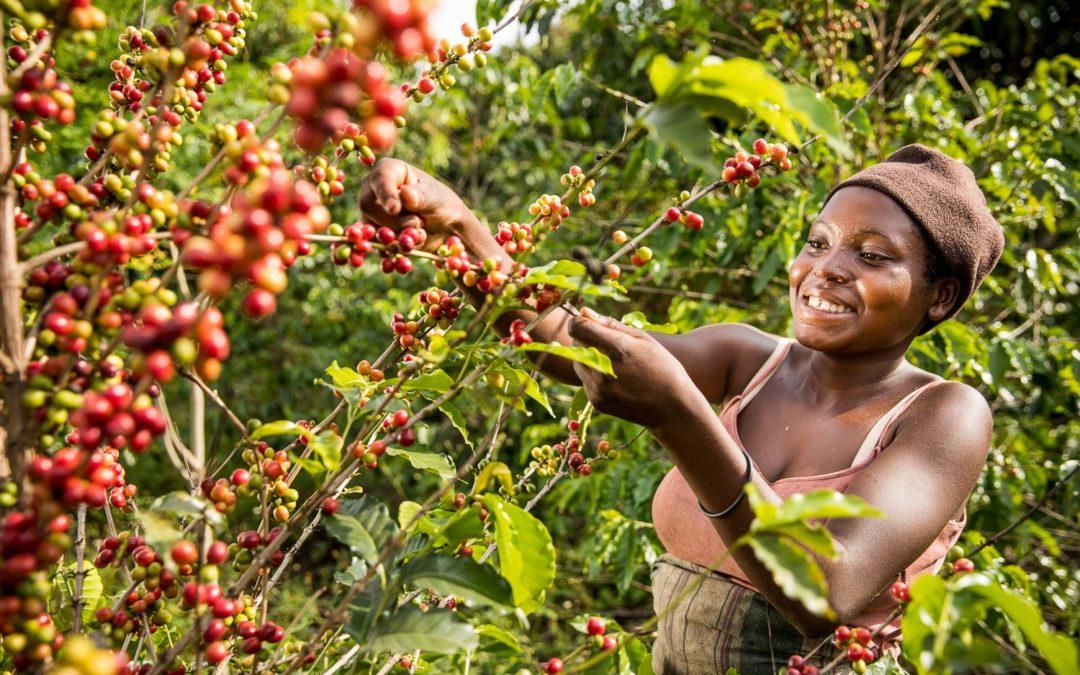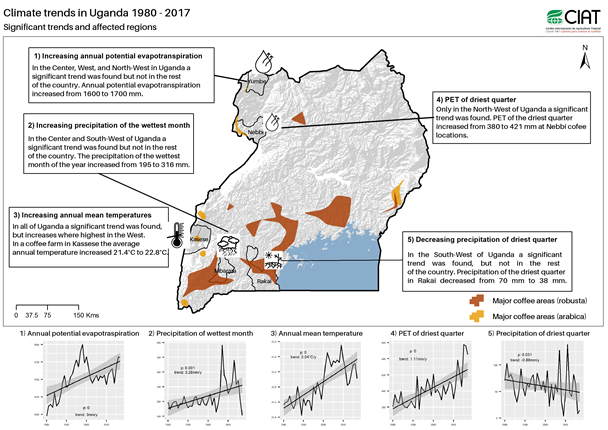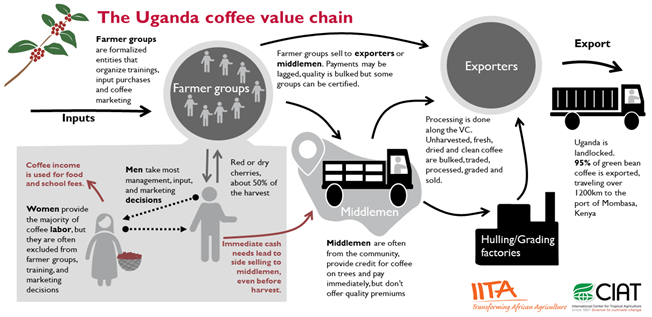Climate-smart coffee in Uganda

At the International Center for Tropical Agriculture (CIAT) we believe that adaptation to climate change should not be driven by a long series of bitter experiences of failed harvests. This is why we are part of the Feed the Future Alliance for Resilient Coffee, a consortium of non-governmental organizations and research institutions working at the intersection of climate change and coffee production.
Women do most of the labor on coffee farms in Uganda
(Picture ©HRNS Alliance for Resilient Coffee Uganda)
In multidisciplinary teams, we help coffee companies reinvest funds in their smallholder producers to preempt hazards through forward-looking climate information. This is done by providing stakeholders with the necessary knowledge to start their own interventions. For Uganda the alliance has developed a climate impact report for the coffee sector to provide decision makers with the necessary background information to start investing in climate adaptation.

Coffee is vital for the economy in Uganda
Uganda is Africa’s second largest coffee producer. Its 1.7 million smallholder coffee households represent 10% of global coffee farms. The annual production of 3–4 million bags coffee accounts for 18% of the country’s annual exports.
About 77% of annual production is Robusta coffee produced in Central Uganda. Arabica is produced on the borders with Rwanda and Kenya. Most production is on small plots (0.25ha) that are intercropped with banana and other food crops.
Coffee production areas in Uganda have become drier and hotter over the past three decades. Annual temperatures have risen across the country, potential evapotranspiration increased, and the distribution of precipitation has become more variable.

Observed climatic trends in Uganda between 1980 and 2017, affected regions and major coffee zones
Global climate models project annual mean temperature to increase by 1.7°C-1.8°C until mid-century. In line with the current trend, the increase is projected to be higher in the South-West, than in the East of Uganda. Projected increases in total annual precipitation are substantial and range from +6.8 % (South West) to +11.5% (South-East) averaged over all projections.
The contradiction that East Africa recently experienced a series of devastating droughts, whereas the majority of climate models predict increasing rainfall for the coming decades has been termed the East African climate paradox. Whether or not the future climate in the region will indeed become wetter or not should be considered an open question.
To support effective adaptation, we developed a gradient of climate change impacts for coffee production. The gradient is a coffee specific evaluation of the projected climatic changes described above. The impact gradient shows that, although most of Ugandan coffee production can be sustained, the majority of the suitable area is in need of substantial adaptation efforts.

Most areas in Uganda will need substantial adaptation effort but with the right germplasm it can be done
Local production systems are maladapted to future conditions and without adaptation, coffee in Uganda would likely become uneconomical with climate change in most regions. However, globally coffee production systems have been adapted to a wider range of climate conditions than currently observed in the country, suggesting that with global technology transfer, especially of germplasm, Uganda may remain suitable for coffee production.

Get the basics right first, then increase investment
Because of the high climate uncertainty for Uganda, we recommend to support site-specific stepwise CSC (Climate Smart Coffee) pathways for adaptation. Our colleagues at the International Institute of Tropical Agriculture (IITA) developed a sequence of farm level practices, in which each step requires additional effort. This aims to make the adoption of these practices feasible for resource-constrained smallholders. As part of the Alliance, the Hanns R Neumann Stiftung (HRNS) is leading climate adaptation training for more than 2,400 producers using the coffee&climate methodology in stepwise CSC pathways.
But to be successful, planning and implementation of interventions for climate-smart practices in Uganda need to consider the system in which coffee producers make their decisions. Informal land tenure, gender relationships, and poor market access are disincentives for CSC adoption. Enabling interventions facilitate and support the adoption of climate-smart technologies and practices by providing services and financing to farmers.

Organizational development is key to unlock incentives for sustainable coffee production in Uganda
Active efforts to scale out climate-smart practices are a priority to secure long-term sustainability of the coffee sector. Because coffee production is an investment of several decades and many CSC practices have a long lead-time, adaptive action needs to be taken immediately with forward-looking thinking. A multi-stakeholder approach will be required as no single technology or scaling pathway may account for the diversity of decision environments of the actors involved.
Download the full report here.
Learn more about the Alliance for Resilient Coffee here.
